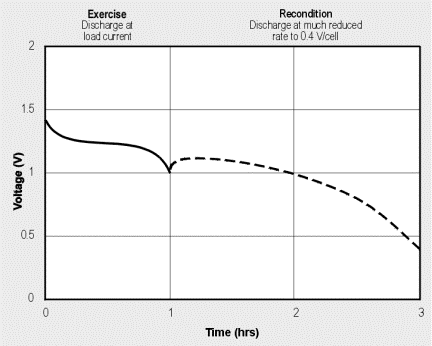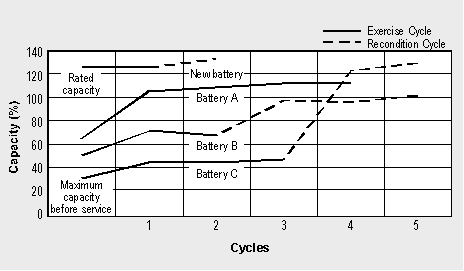<< Previous page INDEX Next page >>
10.2 How to Restore and Prolong Nickel-based Batteries
The effects of crystalline formation are most pronounced if a nickel-based battery is left in the charger for days, or if repeatedly recharged without a periodic full discharge. Since most applications do not use up all energy before recharge, a periodic discharge to 1V/cell (known as exercise) is essential to prevent the buildup of crystalline formation on the cell plates. This maintenance is most critical for the NiCd battery.
All NiCd batteries in regular use and on standby mode (sitting in a charger for operational readiness) should be exercised once per month. Between these monthly exercise cycles, no further service is needed. The battery can be used with any desired user pattern without the concern of memory.
The NiMH battery is affected by memory also, but to a lesser degree. No scientific research is available that compares NiMH with NiCd in terms of memory degradation. Neither is information on hand that suggests the optimal amount of maintenance required to obtain maximum battery life. Applying a full discharge once every three months appears right. Because of the NiMH battery’s shorter cycle life, over-exercising is not recommended.
A hand towel must be cleaned periodically. However, if it were washed after each use, its fabric would wear out very quickly. In the same way, it is neither necessary nor advisable to discharge a rechargeable battery before each charge — excessive cycling puts extra strain on the battery.
Exercise and Recondition — Research has shown that if no exercise is applied to a NiCd for three months or more, the crystals ingrain themselves, making them more difficult to break up. In such a case, exercise is no longer effective in restoring a battery and reconditioning is required. Recondition is a slow, deep discharge that removes the remaining battery energy by draining the cells to a voltage threshold below 1V/cell.
Figure 10-2: Exercising and reconditioning batteries on a Cadex battery analyzer.
This illustration shows the battery voltage during a normal discharge to 1V, followed by the secondary discharge (recondition). Recondition consists of a discharge to 1V/cell at a 1C load current, followed by a secondary discharge to 0.4V at a much reduced current. NiCd batteries affected by memory often restore themselves to full service.Tests performed by the US Army have shown that a NiCd cell needs to be discharged to at least 0.6V to effectively break up the more resistant crystalline formation. During recondition, the current must be kept low to prevent cell reversal. Figure 10-2 illustrates the battery voltage during normal discharge to 1V/cell followed by the secondary discharge (recondition).
Figure 10-3 illustrates the effects of exercise and recondition. Four batteries afflicted with various degrees of memory are serviced. The batteries are first fully charged, then discharged to 1V/cell. The resulting capacities are plotted on a scale of 0 to 120 percent in the first column. Additional discharge/charge cycles are applied and the battery capacities are plotted in the subsequent columns. The solid black line represents exercise, (discharge to 1V/cell) and the dotted line recondition (secondary discharge at reduced current to 0.4V/cell). On this test, the exercise and recondition cycles are applied manually at the discretion of the research technician.
Figure 10-3: Effects of exercise and recondition.
Battery A improved capacity on exercise alone; batteries B and C required recondition. A new battery with excellent readings improved further with recondition.Battery A responded well to exercise alone and no recondition was required. This result is typical of a battery that has been in service for only a few months or has received periodic exercise cycles. Batteries B and C, on the other hand, required recondition (dotted line) to restore their performance. Without the recondition function, these two batteries would need to be replaced.

